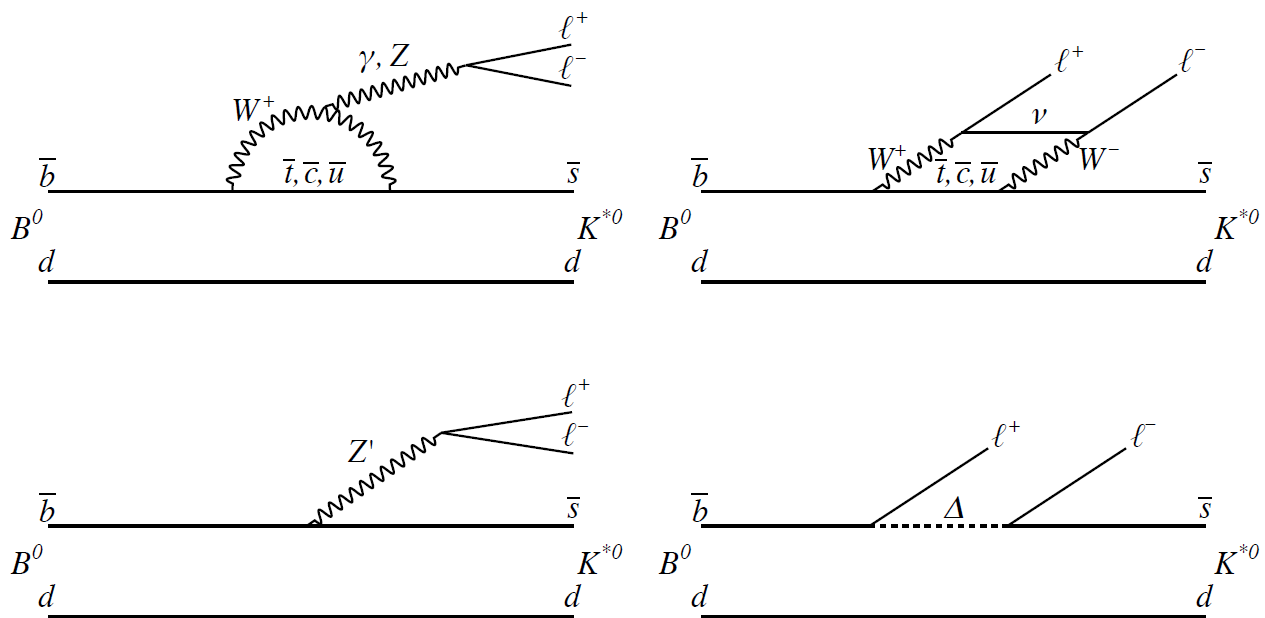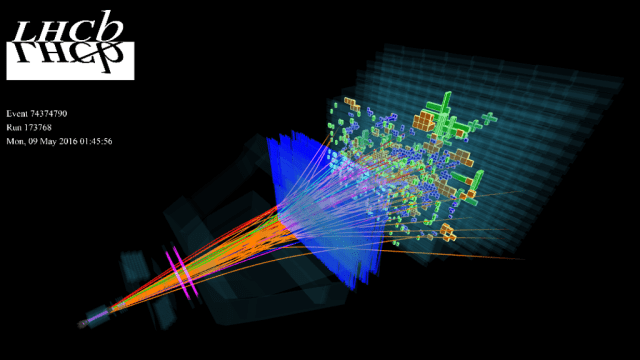Conceptually, particle physics experiments are surprisingly simple. Smash a buttload of particles together, and look at what comes out. The results will either confirm whatever the business-as-usual theory is, or, if there’s a really crystal clear deviation from that theory, they might prove some new hypothesis about some new particles. But the middle ground, where the difference between what we know and what we see is still fuzzy, is where a lot of results live.
A computer reconstruction of the stuff LHCb detects (Image: CERN)
New results from LHCb, one of the experiments observing particle collisions at the Large Hadron Collider in Geneva, Switzerland, are showing one such fuzzy discrepancy. Physicists are cautiously excited, because if these results hold up, they would imply the existence of some brand-new particles. Unlike last year, when a small signal that seemed like it could have been something new turned out to be just a statistical fluke, these new results are popping up in the wake of another hint observed in a different way a few years ago that hasn’t gone away. So, this time, there may really be something there.
If these signals do turn out to indicate real discoveries, it might “imply the existence of some new kind of particles or other physics that’s still unknown,” LHCb physics coordinator Vincenzo Vagnoni told Gizmodo. “This is a way to unveil the existence of a new family of particles.”
LHC beauty, or LHCb, is a building-sized detector placed around one of the points of the intersecting Large Hadron Collider tubes where particles slam together. Protons and neutrons are combinations of three particles called “up” and “down” quarks, but there are four other heavier quarks you don’t usually hear about, called the charm, strange, top and bottom quarks. LHCb focuses on measuring the properties and decays of B mesons, a special combination of two quarks containing antimatter version of the bottom quark and the regular matter version of other kinds of quarks.
These B mesons quickly decay into a collection of other particles, and for the newest research, LHCb scientists focused on a specific B meson, the B0, decaying into a particle called the kaon, and either a pair of electrons or a pair of muons.

These are Feynman diagrams representing the B0 decays. The reactions start on the left side and end on the right side. The top two diagrams represent what we predict from the standard model, where squiggles in the middle are virtual particles that appear and disappear during the decay. The bottom two diagrams were created to explain the anomaly that physicists are observing, and would require a new kind of virtual particle, either the Z’ or the “Delta leptoquark.” Image: LHCb Collaboration
Muons and electrons are the same kind of particle (called leptons), but muons outweigh their electron cousins by a factor of about 200. Their similarity implies that B0s should decay into equal amounts of the two. But yesterday at a seminar, scientists at LHCb reported that B0s decayed into muons less often than the theory predicted. This violation of “lepton universality” would require the presence of never-before-observed particles.
The results weren’t huge — the difference between the observation and what’s expected according to the usual theory of particle physics, the Standard Model, was only significant to 2.2 to 2.5 standard deviations, or “sigma”. This means the scientists don’t have enough data to claim a discovery — they have some weird statistics that only have a one per cent chance of happening by accident. Physicists usually require 5 sigma, or a one in 3.7 million chance of a difference happening by chance. The only way to increase your sigma value is to collect more data points, which would decrease the chance of the result being caused by random chance.
Everyone is being cautious. Last year, a 3.6 sigma fluctuation washed away with more data, much to the disappointment of many physicists hoping for some never-before-seen particles to look at.
[referenced url=”https://gizmodo.com.au/2016/08/its-official-the-lhc-didnt-find-a-new-particle/” thumb=”https://i.kinja-img.com/gawker-media/image/upload/t_ku-large/yaqzmokxj2meznfnwrlg.jpg” title=”It’s Official: The LHC Didn’t Find A New Particle” excerpt=”Well, shoot. It’s been confirmed that early hints of a possible exotic new particle at the Large Hadron Collider in Switzerland have vanished. That disappointing news was announced last night at a physics conference in Chicago.”]
But this data is a little different. Three years ago, LHCb observed a similar anomaly when observing decays in a different B meson, the B+, with a 2.6 sigma significance. “The fact that we find this discrepancy with limited statistical significance is tantalising,” said Vagnoni. “It adds into a framework of anomalies that we have been observing for some years in this sector. Even if the significance isn’t yet at the discovery, this is important in itself.”
This new particle wouldn’t look like an electron or proton — it would be a virtual particle that briefly pops into existence then disappears as part of the decay reaction that we can’t directly detect. We already know some virtual particle exists in this reaction, but it might be a different virtual particle than we expect, because depending on which virtual particle appears, the outcome of the reaction or decay would differ. These particles are kind of like different people deciding the outcome of wrestling matches based on which wrestlers enter the ring — people that we know are an important part of the experience whose actions we don’t directly observe.
The LHCb folks are excited about the possibility of a new particle and hope that they will have the statistics to either prove or disprove these results soon, maybe even in the next six months, said Vagnoni. But they’re cautious as hell until then. “Let let me stress once again that we are not yet at the statistical significance needed to claim a discovery,” he said. “This is a tantalising hint that something might be wrong with the Standard Model, but we need more statistics to definitely establish that this is not a weird statistical fluctuation.”
